It looks like you're using an Ad Blocker.
Please white-list or disable AboveTopSecret.com in your ad-blocking tool.
Thank you.
Some features of ATS will be disabled while you continue to use an ad-blocker.
4
share:
I made these pictures over a year ago when I was bored one day and decided to code a program which would produce pictures based on mathematical
equations. The method was fairly simple, I just cycled through each pixel on the canvas and determined the RGB colour based on the X and Y position of
the current pixel. The RGB colour can be represented as a simple integer so it was very easy to do. For instance, say I was at X=50 and Y=25... if I
was using the equation C=X*Y then C (the RBG colour) would be equal to 1250, and that colour would be applied to the pixel at 50,25.
So there's nothing really special about this, but the results were pretty stunning when I used certain equations to determine the colour. I just found them on my computer again and figured I should post them because they look super cool. I wasn't really sure where to post this, we need some sort of maths/numbers/statistics/charts forum if you ask me. Now that our phones are more powerful than the computers we used to get to the Moon, anyone is capable of making brilliant mathematical discoveries, it's easier than you imagine. There's a lot we still don't understand, like prime numbers.
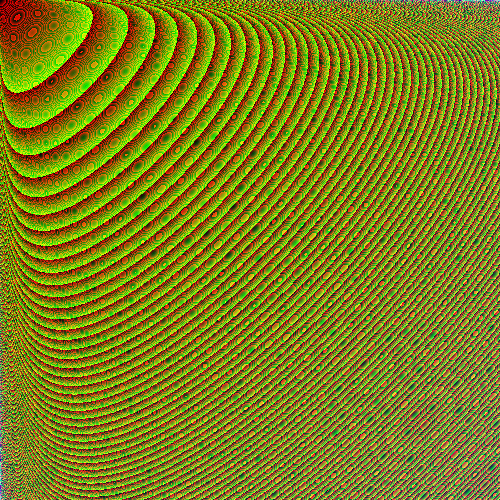
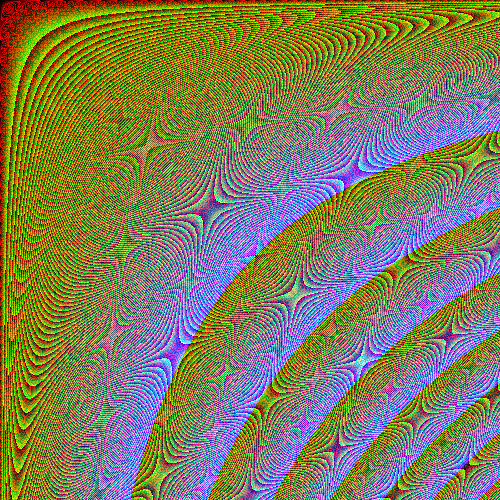
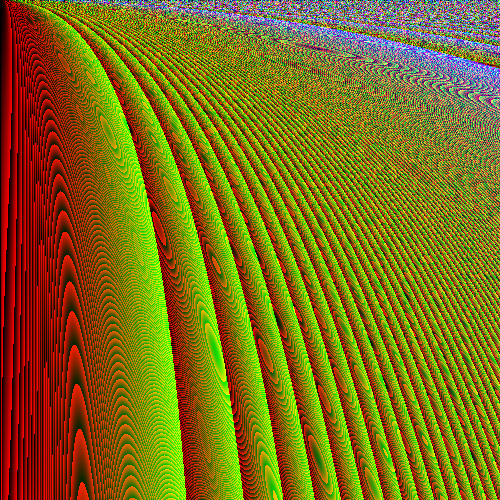

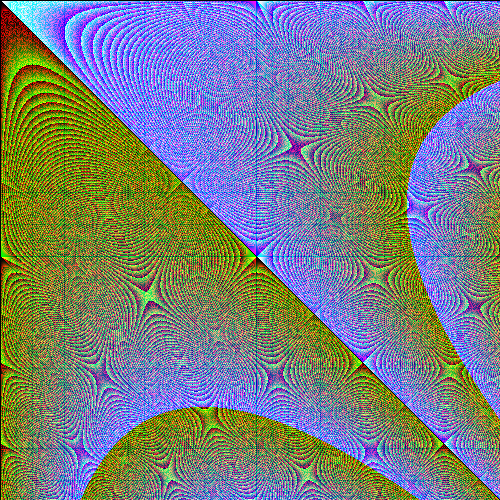

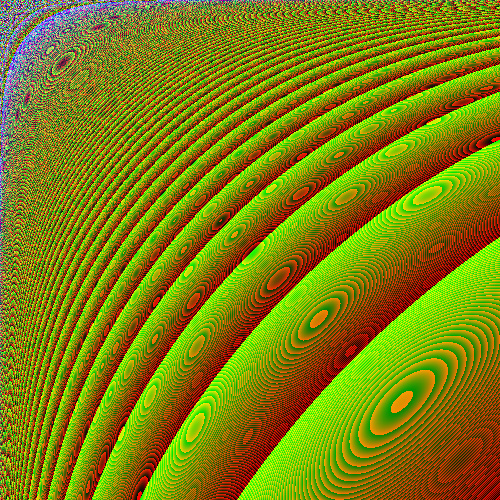

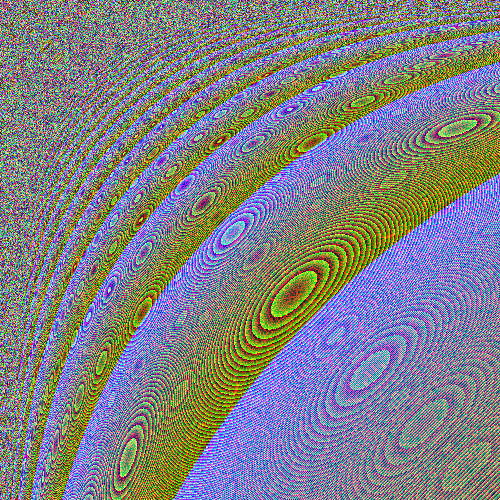
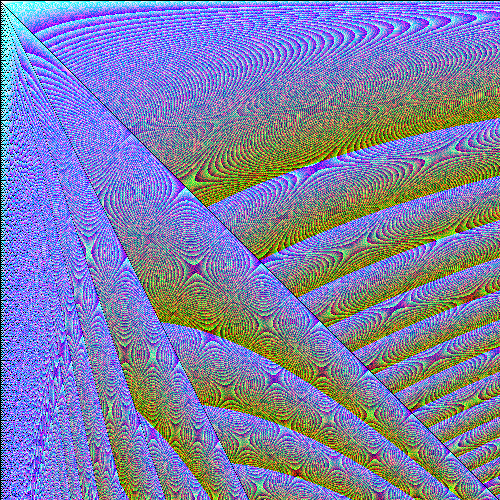
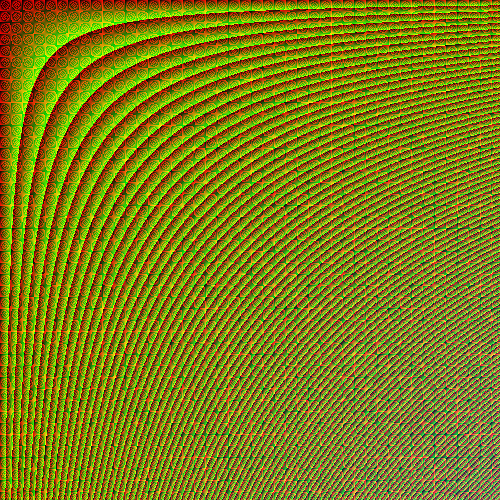

So there's nothing really special about this, but the results were pretty stunning when I used certain equations to determine the colour. I just found them on my computer again and figured I should post them because they look super cool. I wasn't really sure where to post this, we need some sort of maths/numbers/statistics/charts forum if you ask me. Now that our phones are more powerful than the computers we used to get to the Moon, anyone is capable of making brilliant mathematical discoveries, it's easier than you imagine. There's a lot we still don't understand, like prime numbers.












edit on 17/7/2012 by ChaoticOrder because: (no reason given)
Pretty cool. Its a visual representation of formulae Something we usually try to visualize while attempting to plug numbers into a equation in our
head in a classroom.
I love that you did this one day because "you were bored". At least you did something somewhat productive. Usually when I am bored I just surf the
ATS threads.
Cool pics
Cool pics
reply to post by hp1229
Heh, I couldn't even visualise these equation in my head if my life depended on it. The results are far too complex, and I can hardly even understand them even by looking at these pictures. I'm not exceptionally good at maths actually, but I know enough to create what I need.
Something we usually try to visualize while attempting to plug numbers into a equation in our head in a classroom.
reply to post by Doodle19815
Well it seemed like a pretty good idea when I thought of it and I was interested to see what sort of results I would get. I had nothing better to do anyway... and doing something productive which requires thinking and brain power is much more entertaining to me, especially when the results could be something amazing.
I love that you did this one day because "you were bored". At least you did something somewhat productive.
What do you mean this isnt special? This is extraordinary. Its one of the best examples we have of how life is made. Mathematical equations, such as
phi repeating over and over until you get a imagine or should I say frequency.
I find it interesting that in your pictures their is a repetitive wave like a frequency.
I find it interesting that in your pictures their is a repetitive wave like a frequency.
I think the CG pictures are brilliant like detailed electric dreams.
reply to post by ChaoticOrder
Very interesting. Did you use a random seed, or increment values?
I also think the patterns are too specific, more artificial than natural. However, there are many designs in nature that also follow progressive sequences.
Good work!
Very interesting. Did you use a random seed, or increment values?
I also think the patterns are too specific, more artificial than natural. However, there are many designs in nature that also follow progressive sequences.
Good work!
reply to post by Infi8nity
C = ((X-Y) % 1+(Y/(1+X))) + ((X/(1+Y)) * (Y+X))²
That could probably be simplified to something less bulky but I was just writing out equations randomly to see what looked good. I couldn't be bothered simplifying it and I don't really have any need to.
EDIT: I just simplified it a little bit to make it easier to read. For those wondering, % is the modulus symbol. It's like the division (/) symbol but it outputs the remainder of the division.
Well, I just meant the process I used to generate them wasn't anything highly unusual or highly complex. Although it was fairly unique, I haven't seen the same thing done before, but then again I can't say I've looked very hard.
What do you mean this isnt special? This is extraordinary. Its one of the best examples we have of how life is made.
Yah, some of the patterns are certainly very amazing, I didn't even program phi or pi into most of the images, in fact I don't think any of the images I posted here used anything but the X and Y values in some sort of equation. For instance the 3rd image, which is highly complex and includes wave-looking patterns, is produced via this equation:
I find it interesting that in your pictures their is a repetitive wave like a frequency.
C = ((X-Y) % 1+(Y/(1+X))) + ((X/(1+Y)) * (Y+X))²
That could probably be simplified to something less bulky but I was just writing out equations randomly to see what looked good. I couldn't be bothered simplifying it and I don't really have any need to.
EDIT: I just simplified it a little bit to make it easier to read. For those wondering, % is the modulus symbol. It's like the division (/) symbol but it outputs the remainder of the division.
edit on 17/7/2012 by ChaoticOrder because: (no reason given)
reply to post by Druid42
EDIT: what we also need to remember here is that the colours are related to the way the RGB colour values are arranged. I assume as you go from 0 to what ever the highest RGB value is, it shifts through the entire colour spectrum in some sort of way related to the Red Green and Blue colour components. I too was amazed to see how much structure there actually is in terms of the colouring.
No, there's no random components in them, the process was a purely deterministic mathematical process. However, you may notice that some of them break into a random fuzz of colours which seems to have no order. That is the nature of chaos theory. Simple equations can break into chaos and produce random looking results with no apparent order. That's what I guess is happening anyway.
Very interesting. Did you use a random seed, or increment values?
No, as I said, it's a purely "natural" mathematical process and nothing more.
I also think the patterns are too specific, more artificial than natural.
EDIT: what we also need to remember here is that the colours are related to the way the RGB colour values are arranged. I assume as you go from 0 to what ever the highest RGB value is, it shifts through the entire colour spectrum in some sort of way related to the Red Green and Blue colour components. I too was amazed to see how much structure there actually is in terms of the colouring.
edit on 17/7/2012 by ChaoticOrder because:
(no reason given)
I also have an idea some people may like. If you guys want to provide me with an equation which uses the X and Y variables, like the one I posted in
reply to Infi8nity, I will test it out see what sort of image it produces. Reveal your inner mathematical intuition through my mystical formulae
readings!
Try and keep the operators fairly simple... use only +, -, /, *, % and exponent operations. You could also incorporate numbers like Phi or Pi into the equations if you desire.
But I'm going to get some sleep in a moment (it's quite late at my location), so I'll get around to it when I get back, if there are any requests.
Try and keep the operators fairly simple... use only +, -, /, *, % and exponent operations. You could also incorporate numbers like Phi or Pi into the equations if you desire.
But I'm going to get some sleep in a moment (it's quite late at my location), so I'll get around to it when I get back, if there are any requests.
edit on 17/7/2012 by ChaoticOrder because: (no reason given)
Damn, no one has any equations they want to try out? I thought it was a good idea. Oh well I'll still do it if anyone wants to try it out.
EDIT: I also discovered the 3rd image can actually be produced using this much simpler equation:
C = ((X/(1+Y)) * (Y+X))²
All I did was remove the first part because it was only adding a tiny little amount to the final value, so removing it doesn't effect the final image (very much).
For those of you who still don't understand the procedure... all I'm doing is shifting through each pixel and applying a colour based on the equation. For pixel 100,125 (X=100, Y=125), all I do is feed in those X and Y values into the equation and use the result (C) as the RGB colour. I do that for every single pixel until I've coloured the entire canvas, which could be any size I choose, in this case I'm outputting 500x500 images.
EDIT: I also discovered the 3rd image can actually be produced using this much simpler equation:
C = ((X/(1+Y)) * (Y+X))²
All I did was remove the first part because it was only adding a tiny little amount to the final value, so removing it doesn't effect the final image (very much).
For those of you who still don't understand the procedure... all I'm doing is shifting through each pixel and applying a colour based on the equation. For pixel 100,125 (X=100, Y=125), all I do is feed in those X and Y values into the equation and use the result (C) as the RGB colour. I do that for every single pixel until I've coloured the entire canvas, which could be any size I choose, in this case I'm outputting 500x500 images.
edit on
17/7/2012 by ChaoticOrder because: (no reason given)
new topics
-
Weinstein's conviction overturned
Mainstream News: 13 minutes ago -
Supreme Court Oral Arguments 4.25.2024 - Are PRESIDENTS IMMUNE From Later Being Prosecuted.
Above Politics: 1 hours ago -
Krystalnacht on today's most elite Universities?
Social Issues and Civil Unrest: 1 hours ago -
Chris Christie Wishes Death Upon Trump and Ramaswamy
Politicians & People: 2 hours ago -
University of Texas Instantly Shuts Down Anti Israel Protests
Education and Media: 4 hours ago -
Any one suspicious of fever promotions events, major investor Goldman Sachs card only.
The Gray Area: 6 hours ago -
God's Righteousness is Greater than Our Wrath
Religion, Faith, And Theology: 11 hours ago
top topics
-
VP's Secret Service agent brawls with other agents at Andrews
Mainstream News: 15 hours ago, 11 flags -
Nearly 70% Of Americans Want Talks To End War In Ukraine
Political Issues: 16 hours ago, 6 flags -
Sunak spinning the sickness figures
Other Current Events: 16 hours ago, 5 flags -
Krystalnacht on today's most elite Universities?
Social Issues and Civil Unrest: 1 hours ago, 5 flags -
Supreme Court Oral Arguments 4.25.2024 - Are PRESIDENTS IMMUNE From Later Being Prosecuted.
Above Politics: 1 hours ago, 4 flags -
Weinstein's conviction overturned
Mainstream News: 13 minutes ago, 4 flags -
Electrical tricks for saving money
Education and Media: 14 hours ago, 4 flags -
University of Texas Instantly Shuts Down Anti Israel Protests
Education and Media: 4 hours ago, 2 flags -
Any one suspicious of fever promotions events, major investor Goldman Sachs card only.
The Gray Area: 6 hours ago, 2 flags -
Chris Christie Wishes Death Upon Trump and Ramaswamy
Politicians & People: 2 hours ago, 1 flags
active topics
-
-@TH3WH17ERABB17- -Q- ---TIME TO SHOW THE WORLD--- -Part- --44--
Dissecting Disinformation • 666 • : daskakik -
University of Texas Instantly Shuts Down Anti Israel Protests
Education and Media • 96 • : CriticalStinker -
Weinstein's conviction overturned
Mainstream News • 7 • : underpass61 -
President BIDEN Vows to Make Americans Pay More Federal Taxes in 2025 - Political Suicide.
2024 Elections • 144 • : underpass61 -
Supreme Court Oral Arguments 4.25.2024 - Are PRESIDENTS IMMUNE From Later Being Prosecuted.
Above Politics • 10 • : Vermilion -
Sunak spinning the sickness figures
Other Current Events • 19 • : Freeborn -
Candidate TRUMP Now Has Crazy Judge JUAN MERCHAN After Him - The Stormy Daniels Hush-Money Case.
Political Conspiracies • 746 • : matafuchs -
Chris Christie Wishes Death Upon Trump and Ramaswamy
Politicians & People • 7 • : underpass61 -
SETI chief says US has no evidence for alien technology. 'And we never have'
Aliens and UFOs • 65 • : andy06shake -
British TV Presenter Refuses To Use Guest's Preferred Pronouns
Education and Media • 155 • : Annee
4
